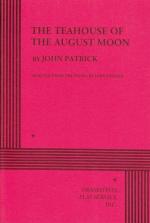|
This section contains 373 words (approx. 1 page at 400 words per page) |

|
The Teahouse of the August Moon Summary & Study Guide Description
The Teahouse of the August Moon Summary & Study Guide includes comprehensive information and analysis to help you understand the book. This study guide contains the following sections:
This detailed literature summary also contains Bibliography and a Free Quiz on The Teahouse of the August Moon by John Patrick.
The Teahouse of the August Moon (1953), by John Patrick, is a comedy about the process of the Americanization of Japanese citizens on the island of Okinawa during the American Occupation of Japan following World War II. A hit Broadway production, Patrick's play won many awards, including the New York Drama Critics Circle Award for Best American Play of the Year, the Pulitzer Prize in drama, and the Antoinette Perry (Tony) Award. Although extremely popular in the 1950s, this play became outdated by the 1970s when increased awareness of racial issues led audiences to recognize the offensive stereotypes of Asian people in the play.
A young military officer, Captain Fisby, is assigned to carry out "Plan B" in a tiny Okmawan village, to begin the process of Americanization by instituting a local democratic government, establishing a capitalist economy, and building a school-house in which the village children will be taught English. Fisby is assigned a local interpreter, SaMni, who attempts to explain to him many of the local customs. Fisby, however, is frustrated when the villagers are unable to market their local products, such as cncket cages and lacquered bowels.
When Fisby appoints a local democratic government, they vote to build a teahouse with the materials intended for the schoolhouse. With the help of Lotus Blossom, a young geisha, Fisby quickly becomes accommodated to the local culture and agrees to the building of the teahouse. In the meantime, he successfully markets a locally made brandy to the surrounding military bases.
When his commanding officer, Colonel Purdy, arrives, Fisby is caught in his bathrobe, a makeshift kimono, in the midst of a tea ceremony and is reprimanded for misusing military resources and for the selling of alcohol. Purdy orders the teahouse lorn down and the distilleries destroyed but the local villagers are clever and only pretend to carry out these orders while secretly preserving both. This proves fortunate, as Purdy learns that the village is to be presented as an example of successful democratization by Occupation Forces.
Teahouse of the August Moon concerns the clash of cultures that results from the American Occupation of Japan. Much of the comedy derives from the inability of American military personnel to understand local culture and tradition.
Read more from the Study Guide
|
This section contains 373 words (approx. 1 page at 400 words per page) |

|



